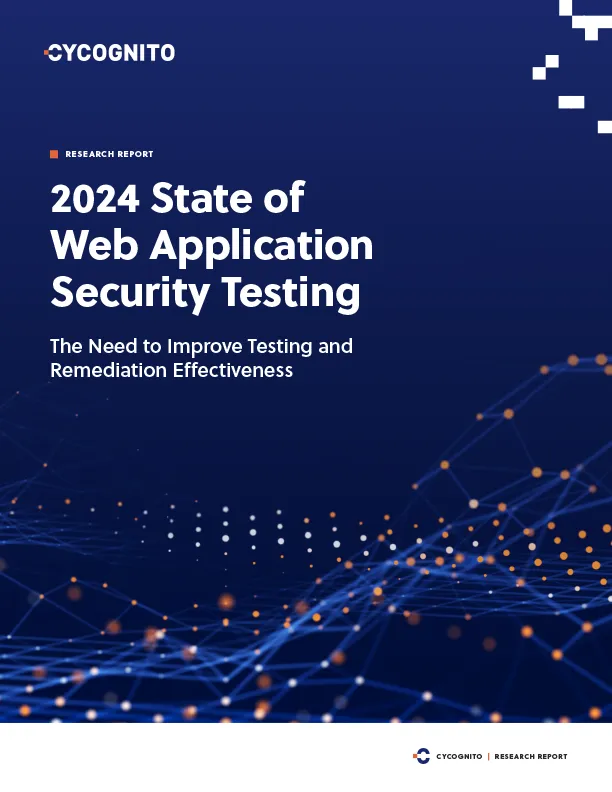What Is Dynamic Application Security Testing(DAST)?
Dynamic application security testing (DAST) is a security testing approach that simulates an external attack on an application. It assesses a program’s runtime behavior without requiring access to the source code. DAST tools attempt to exploit an application to identify vulnerabilities, providing insights into potential security issues. This method is useful in discovering vulnerabilities like SQL injection, cross-site scripting (XSS), and other web-based threats, helping developers address these issues before deployment. It is often used in conjunction with web application penetration testing.
DAST integrates into the later stages of the software development lifecycle, allowing for real-time feedback on running applications. Its ability to test applications in their operational environment provides a way of securing applications post-deployment. While DAST cannot investigate elements related to the application’s internals, it complements other security measures by revealing real-world vulnerabilities that might otherwise be missed.
This is part of a series of articles about application security.
What Is Manual PenetrationTesting?
Manual penetration testing is a hands-on approach to identifying and evaluating vulnerabilities in an application or system. Unlike automated tools, manual testing is conducted by skilled security experts who simulate attack scenarios. These testers manually analyze security gaps that automated tools may overlook, such as complex business logic flaws, multi-step attacks, or subtle configuration issues.
This method is effective in evaluating the security of custom applications and complex network environments. Manual penetration testers use a blend of tools and techniques, applying their expertise to adapt to an application’s unique features and defenses. The results offer deeper insights into potential security issues, providing actionable recommendations tailored to the specific application or system.
What Is Penetration Testing as a Service(PTaaS)?
Penetration Testing as a Service (PTaaS), a managed form of automated penetration testing, is a cloud-based model that provides organizations with ongoing access to penetration testing resources and expertise. Through PTaaS platforms, companies can continuously schedule, execute, and manage penetration tests, often with access to real-time results and detailed reports. This approach enables regular vulnerability assessments without the logistical overhead associated with traditional, one-time penetration tests.
PTaaS typically includes features like automated scanning, integration with CI/CD pipelines, and dashboards for tracking security issues. By offering a flexible, on-demand testing model, PTaaS helps organizations maintain a proactive security posture, identifying vulnerabilities early and allowing for quick remediation in dynamic development environments.
How Is a Typical Pen Test CarriedOut?
Manual Penetration Test
In a manual penetration test, security professionals follow a structured methodology to identify vulnerabilities. The first stage is typically planning and scheduling. Penetration testers should carefully coordinate their tests to make sure they don’t disrupt production activity or risk critical systems.
When a test is scheduled it typically begins with reconnaissance, where testers gather information about the target environment to understand its structure and potential entry points. This phase may include passive activities, like scanning publicly accessible information, as well as active scanning to map the network and detect open ports and services.
After reconnaissance, testers perform a vulnerability analysis. Here, they examine the target’s infrastructure, looking for known security weaknesses using both automated tools and manual inspection techniques. The testers then attempt exploitation, where they simulate attacks based on identified vulnerabilities to see if unauthorized access, data exfiltration, or system compromise is possible.
Following exploitation, testers move into post-exploitation analysis. They assess the extent of the impact an attacker could have if the vulnerabilities were exploited, including access to sensitive data or persistence within the system. Finally, they compile a detailed report outlining the vulnerabilities discovered, the impact of each, and recommendations for mitigation.
Automated Penetration Test
An automated penetration test leverages software tools to scan and assess applications and systems for vulnerabilities. This process starts with configuring the testing tool, often specifying parameters like target IP ranges, authentication credentials, and the level of test aggressiveness. Once configured, the automated tool begins scanning the system, identifying weaknesses by comparing it against a database of known vulnerabilities, such as misconfigurations, outdated software versions, or unsafe default settings.
Automated tools proceed to simulate attacks, like injecting code or sending malformed requests, to probe for possible exploitation. While they follow predefined scripts, these tools are effective at rapidly assessing a broad surface area of the application or network. The test results are typically displayed in a report, highlighting discovered vulnerabilities and categorizing them by severity level.
Automated penetration tests can be guided by human experts to identify complex or context-specific vulnerabilities, such as logic flaws or chained exploits. They provide a baseline level of security that identifies vulnerabilities quickly and efficiently.
How Does DAST Work?
Dynamic application security testing (DAST) works by interacting with a running application in real-time, simulating the actions of an attacker. Unlike static analysis, which looks at code structure, DAST focuses on the application’s behavior during execution:
- Setup and configuration: This can include specifying the target URL or application, setting the scope (which pages or endpoints should be tested), and defining scan parameters such as depth and frequency. Some DAST tools allow users to configure specific attack vectors or customize tests based on the application’s technology stack.
- Request-response analysis: DAST tools interact with the application by sending HTTP requests and analyzing the responses. These tools simulate malicious inputs, such as injecting SQL queries or cross-site scripting (XSS) payloads, to see how the application responds.
- Attack simulation: During the scanning process, DAST tools simulate various attack scenarios, such as trying to manipulate user sessions, bypass authentication, or escalate privileges. They look for behaviors that indicate the application is handling data insecurely or improperly. This real-time simulation is key to identifying runtime vulnerabilities that wouldn’t be apparent from just inspecting the code.
- Report generation: Once the scan is complete, DAST tools generate a report. The report includes information on vulnerabilities discovered, the severity of each issue, and remediation guidance. DAST reports typically categorize issues based on common vulnerability types, such as SQL injection, XSS, and insecure direct object references, and may provide links to industry standards like the OWASP Top 10.
- Continuous integration and retesting: DAST tools are often integrated into CI/CD pipelines to provide ongoing security assessments throughout the software development lifecycle. This allows for automatic scanning whenever new code is deployed, ensuring vulnerabilities are detected and addressed early in the process. Retesting ensures that previously identified vulnerabilities have been patched correctly.
Tips from the Expert

Dima Potekhin, CTO and Co-Founder of CyCognito, is an expert in mass-scale data analysis and security. He is an autodidact who has been coding since the age of nine and holds four patents that include processes for large content delivery networks (CDNs) and internet-scale infrastructure.
In my experience, here are insights to help you understand the nuances between DAST and penetration testing and enhance their effectiveness:
- Combine DAST with SAST for holistic vulnerability coverage: Use DAST in conjunction with Static Application Security Testing (SAST) and Software Composition Analysis (SCA) to catch both runtime and code-level vulnerabilities. SAST can identify code-level issues such as weak cryptography and insecure configurations, while DAST reveals runtime vulnerabilities, enhancing overall coverage.
- Leverage AI in DAST to reduce false positives: Some DAST tools now incorporate machine learning to improve detection accuracy and minimize false positives. Consider tools that use AI to learn from past scans, improving the precision of vulnerability detection and reducing manual verification overhead.
- Test beyond standard configurations in DAST: Configure DAST tools to test unusual inputs and non-standard configurations that could be exploited, such as large payloads, boundary conditions, and non-default HTTP headers, which could reveal hidden vulnerabilities not caught in typical scans.
- Monitor for chained exploitability with DAST and pen testing results: Use the findings from DAST scans to simulate and assess potential attack chains with manual testing. For instance, chaining an XSS vulnerability identified by pen testing with an insecure redirect identified by DAST could reveal impactful multi-step attack scenarios.
- Use pen testing for configuration drift detection in dynamic environments: As configurations can change frequently in DevOps environments, leverage pen testing to verify DAST findings periodically and detect “configuration drift.” This practice ensures that both software and configuration changes don’t introduce new vulnerabilities that automated scans might miss.

2024 State of Web Application Security Testing
Are you confident your web application security measures are keeping pace with evolving threats?
Discover how your web app security compares. Learn about average testing frequency, the prevalence of web application security incidents and breaches, and the increasing adoption of automation to improve testing efficiency.

DAST vs. Manual Pen Testing vs. Automated PenTesting
1. Web Asset Coverage
- DAST: DAST tools primarily target web applications and associated interfaces (APIs, web services) by simulating attacks against a running application. It is suitable for discovering vulnerabilities in applications accessible over HTTP/HTTPS.
- Manual Pen Testing: This approach is flexible and can cover web applications and network services. Skilled testers can assess assets not typically covered by automated tools, such as legacy systems or applications with custom protocols.
- Automated Pen Testing: Automated tools are designed to scan a range of IP addresses and applications, covering the basic structure of assets but often missing context-specific issues or complex integrations.
2. Level of Automation
- DAST: Fully automated DAST tools require minimal manual configuration, but are typically not designed to run in production environments, because they can have unexpected impacts on production systems.
- Manual Pen Testing: No automation. Security experts manually explore and probe the application or network, making it useful for identifying nuanced vulnerabilities that automated tools might miss.
- Automated Pen Testing: Mostly automated, but some tools offer customization options to refine the testing scope. Automated pen testing can be guided by experts to enhance the coverage or to validate specific findings.
3. Speed and Cost
- DAST: Faster than manual testing, DAST tools provide rapid feedback once an application is deployed. They are typically cost-effective but may require licenses or subscription fees.
- Manual Pen Testing: Slowest and most resource-intensive. The time and cost depend on the complexity of the environment and the expertise of the testers. However, it often yields the most thorough and accurate results for high-stakes applications.
- Automated Pen Testing: Faster than manual testing and cost-effective for frequent scans. However, the depth of coverage may be limited to predefined vulnerabilities and configurations.
4. Depth and Breadth of Testing
- DAST: Broad testing across the surface of the application but lacks deep insight into business logic or internal application structure. DAST is effective for finding common runtime vulnerabilities but does not handle application-specific logic well.
- Manual Pen Testing: Deepest level of analysis. Testers analyze both surface-level and nuanced vulnerabilities, including complex attack chains or flaws in business logic. Manual testing is highly adaptable and provides a thorough evaluation of application security.
- Automated Pen Testing: Broad coverage but limited in depth. Automated pen tests scan for known vulnerabilities across various system components but often miss complex issues like chained attacks or subtle logic flaws.
5. Types of Vulnerabilities Found
- DAST: Common runtime vulnerabilities, such as SQL injection, cross-site scripting (XSS), and insecure direct object references. Limited in detecting logic flaws or issues that require a deep understanding of the application’s intended behavior.
- Manual Pen Testing: Comprehensive vulnerability identification, including complex issues like business logic flaws, multi-step attacks, and chained vulnerabilities that automated tools typically cannot detect.
- Automated Pen Testing: Effective at identifying standard, known vulnerabilities (e.g., outdated software versions, configuration issues, and missing patches). Less effective for detecting context-specific or complex attack patterns.
How Is DAST Used by PenetrationTesters?
Penetration testers often incorporate DAST into their workflow to gain a comprehensive view of an application’s vulnerabilities before diving into more complex, manual assessments. By using DAST tools as a preliminary step, pen testers can automate the detection of common vulnerabilities, such as SQL injection, cross-site scripting (XSS), and insecure configuration issues. This helps them quickly identify low-hanging fruit that may be immediately exploitable.
Additionally, DAST results provide useful insights into an application’s security posture, highlighting areas that may warrant further examination during manual testing. For instance, if DAST reveals repeated input validation failures across various endpoints, pen testers can target these areas to explore deeper flaws, such as authentication bypass or privilege escalation opportunities that are not apparent through automated scanning alone.
Pen testers also rely on DAST’s continuous scanning capabilities, especially in agile environments where applications are regularly updated. By integrating DAST into CI/CD pipelines, they can automatically scan each new build, maintaining an up-to-date understanding of vulnerabilities that may emerge as the codebase evolves.
Penetration Testing vs. DAST: How toChoose?
When deciding between penetration testing and dynamic application security testing (DAST), organizations need to evaluate their specific security goals, the complexity of their applications, and the resources available.
Keep in mind that penetration tests often use DAST tools, and automated DAST scans can be run alongside penetration tests. So in many cases, organizations will use both penetration testing and DAST.
Security Depth vs. Coverage Needs
If your primary concern is depth and the ability to uncover sophisticated, multi-layered vulnerabilities, penetration testing is the better option. Manual pen testers or PTaaS services can analyze the context of vulnerabilities and combine them to simulate real-world attacks, uncovering complex issues that automated tools often miss.
On the other hand, if broad coverage across all web assets is a priority, especially for large or frequently updated applications, DAST provides a more efficient solution. Automated DAST tools can be run continuously and on a larger scale, identifying common vulnerabilities across the entire application environment without manual intervention.
Frequency of Testing
For organizations with a need for ongoing security monitoring and frequent testing, especially in fast-moving DevOps or agile environments, DAST is ideal. Integrated into CI/CD pipelines, DAST allows for regular scans with minimal disruption, ensuring vulnerabilities are detected early in the development process.
Penetration testing, being more manual and resource-intensive, is typically conducted less frequently. Manual pentesting is often carried out quarterly or annually, and while PTaaS can be performed much more often, it is still far more resource intensive than a simple DAST scan.
Risk Appetite and Compliance Requirements
Organizations in highly regulated industries or with strict compliance requirements might need both DAST and penetration testing. Penetration testing provides the depth needed to meet rigorous standards, ensuring that even the most complex vulnerabilities are addressed. DAST, on the other hand, can ensure continuous compliance by catching common vulnerabilities on an ongoing basis.
For organizations with lower risk tolerance or those focused on ensuring security for rapidly changing applications, combining both methods can offer the most comprehensive protection.
Budget and Resource Allocation
Cost is a significant consideration when choosing between DAST and penetration testing. DAST can be more cost-effective due to its automated nature and ability to scan repeatedly without additional human effort. This makes it a good choice for organizations with tighter budgets or those needing frequent tests.
Penetration testing, with its reliance on skilled human testers, is more expensive and resource-heavy. It’s typically reserved for high-risk systems or for organizations with the budget to invest in deep security assessments.
Automated Penetration Testing withCyCognito
CyCognito built its external attack surface management (EASM) and security testing platform to replicate an attacker’s thought processes and workflows.
CyCognito automates the first phase of offensive cyber operation with deep reconnaissance and active security testing. Pen testing and red teaming staff are able to immediately focus on meaningful activities that require human decision.
With CyCognito, your teams have access to:
- Continuously updated reconnaissance information – Dynamic updates to your full asset inventory across all business divisions and brands – seed information and manual updates are not required.
- Automatic black box penetration test results – Over 30,000 penetration testing modules applied to full inventory of exposed network infrastructure and web applications.
- Integrated threat intelligence and remediation planning services – Guidance on which assets to test first, with evidence.
- Workflows built for collaboration – Create subteams dedicated to specific pen testing and red team staff. Organizations and assets can be assigned per team based on predefined scopes. Instant access to what to test next.
With CyCognito your offensive security teams can pivot faster to human-led exploitation-based tests:
- Reduce time consuming and tedious reconnaissance work
- Reach your ideal security testing goals
- Reduce burnout and get better results
- Get more ROI out of bug bounty programs
- Learn more about CyCognito for automated security testing

2024 State of Web Application Security Testing
Are you confident your web application security measures are keeping pace with evolving threats?
Discover how your web app security compares. Learn about average testing frequency, the prevalence of web application security incidents and breaches, and the increasing adoption of automation to improve testing efficiency.














